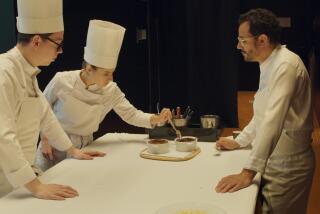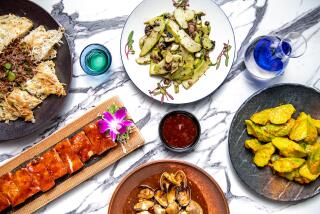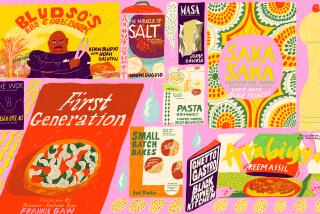BOOK REVIEW : A Case of the Cordon Blues : Le Cordon Bleu at Home <i> (Hearst Books: $37.50; 578 pp.)</i>
“Buy this cookbook and join the elite” is not a new message--people were falling for it at least as early as the 17th Century. But every so often it reaches a new level of silliness. “Le Cordon Bleu at Home” is such a benchmark. What it proclaims itself to be is “the ultimate state-of-the-art book on French cuisine.” What it actually offers is a pricey membership in the Emperor’s Clothes Society.
The emperor might have had at least a pair of pants to his name if this pompous production had focused on its stated aim as a teaching manual composed of progressive tyro-to-master “lessons.” That aim is sabotaged at every turn by some loony decision or other.
The crucial things to have straight in your mind before starting to instruct others are whom and what you are teaching. After that you can get to work on the how . In this book, unfortunately, the first two essentials are hopelessly fudged. No wonder everything else unfolds so incoherently as the work proceeds.
For their target audience the anonymous authors seem to picture people who are both terribly superior and rock-bottom ignorant. They seem to see no discrepancy in addressing someone previously unaware that “bones, water and vegetables can be made into flavorful, richly colored stocks” and someone who will know (without being told) what’s meant by “sea bream” or “Parma ham” and will be able to reach effortlessly for the fish poacher or the graduated set of tinned French tartlet pans.
Rather than introducing naive beginners to first essentials and then following up with steadily expanding knowledge, the book teaches how to execute a certain number of French-titled set pieces. It never explains how to make sense of the elements that go into them.
Real cooking is all bits of gradually conquered understanding connected with ingredients, equipment and heat: knowing what makes one kind of apple suitable for a dish, getting the feel of a knife properly held for slicing or chopping, choosing a wider or deeper cooking vessel depending on your purpose, recognizing that a food mill will produce a certain result where a food processor won’t, judging the temperature of sizzling butter by smell and sound as well as look. Eventually these inklings should mesh in your mind like the grammar of a new language. They are exactly the sort of things that are never discussed in the “Cordon Bleu at Home” recipes. This is the kind of teaching that means official formulas carved in the most expensive marble you can buy.
The set-piece mentality essentially undercuts any sequential learning process. We are given three sections labeled “Pratique de Base” (“Getting Started”), “Intermediaire” (“Perfecting Skills”) and “Superieure” (“Professional Touches”). Each section consists of 30 “lessons”--and the “lessons,” instead of telling you what flour is all about or how to sweat onions without browning them, present small handfuls of recipes arranged like menus. And not menus from which one could learn how French people put meals together. Instead we get never-never pairings like scrambled eggs and asparagus in puff pastry cases followed by lobsters a l’americaine and, for dessert, a pineapple cake of genoise layers covered in meringue and decorated to look like a pineapple.
Even leaving out the weirdness of these pseudo-menus, the “lesson” arrangement turns out to be terribly capricious and hard to follow. Why one dish turns up in the same grouping as another tends to be a mystery. There isn’t even a decent table of contents for easy back-and-forth reference to the contents of different lessons.
And on close examination the beginning-intermediate-advanced organization really falls apart. True, many simple preparations such as roast chicken or plain boiled potatoes are given in the first section and many more elaborate ones in the last two parts. But a lot of things also seem to have been tossed up in the air and left wherever they fall. It beats me why profiteroles filled with sauce Mornay have to be presented in “Pratique de Base” while simple basics like fish fumet or clarified stock are relegated to “Intermediaire” and aspic to “Superieure.”
If all the food shone with naturalness and charm, that would teach a good deal in itself. But the one thread of continuity leading from the beginner to the advanced section is more and more pretentious manipulation of ingredients as you go along. The occasional robust stew, classic fish soup or agreeable vegetable salad is increasingly overshadowed by the sort of smarmy flourishes the authors eventually pause to preen themselves on:
“When is a steak more than a steak? When it is a steak Mirabeau , crisscrossed with anchovy fillets and served with an anchovy butter. Simple? Absolutely. Little touches, like the anchovies, transform a familiar dish into a symphony of tastes. . . .”
Their point is that by the time all of us home-based students get to “Superieure,” we’re ready to show our parity with a figure called “the chef” by means of fussy touches (“attention to detail”) in the service of elaborate brainstorms (“creative approach”).
There remains another unpleasant surprise for anyone impressed enough with the Cordon Bleu name to try using this book. The publishers have come up with a stunningly foolish design. Forget the decision to use a coated paper stock so heavy that the finished volume weighs five pounds, and the bright idea of printing all page numbers in white against a stylized blue ribbon so as to discourage use by persons with less than 20/20 vision. Much worse is the handling of the pictures. Nearly 260 instructional color photographs were commissioned for “Le Cordon Bleu at Home”: trimming artichokes, filleting fish, “turning” puff pastry, etc. They have all been plunked down in a body at the very end of the book, miles away from the printed recipes and sidebars they’re supposed to illustrate.
One fatuous comment, of many sprinkled throughout these pages, really seems to sum up the wrongheadedness of the effort. Acknowledging that the “lesson” menus may be a little peculiar, the authors waffle: “The menus are constructed for maximum teaching results, and as such they may require some rearranging before they suit your ‘real life’ needs.” Maximum teaching results, indeed. I would expect the same kind of teaching results at a violin school where they train people to play double stops without ever having heard of the C major scale.


